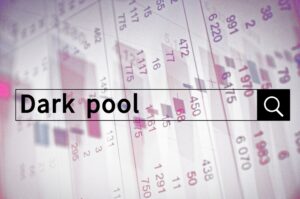Dark Pools: What They Are and How They Affect Day Trading
In the intricate world of financial markets, dark pool trading and day trading impact remain topics of intrigue and importance for traders of all levels. Dark pools are private, off-exchange trading venues where institutional investors and large players execute large orders discreetly. Unlike public exchanges like NASDAQ or NYSE, these trades do not immediately reflect in the visible market order book, making them “dark” to the rest of the market.
How Dark Pools Work
Dark pools operate to facilitate large transactions with minimal market disruption. For example, if an institutional investor wants to buy a million shares of a stock, executing the order on a public exchange could cause the price to spike due to increased demand. Dark pools help such investors avoid this by allowing the trade to occur outside the public eye.
These platforms often match buy and sell orders internally or route them to other institutional buyers and sellers. While this ensures efficiency for large players, it also means that day traders have limited visibility into the full scope of market activity.
The Impact on Day Trading Price Action
Dark pool trading significantly influences day trading price action, especially for stocks with high institutional interest. Since these trades don’t appear on Level II order books or during normal trading, they can lead to sudden, unpredictable price movements when the information becomes public.
Here’s how dark pool activity can affect day traders:
- Delayed Price Reactions: Large trades in dark pools may affect the market hours later when the information is disclosed, causing abrupt price spikes or drops.
- False Signals: Without visibility into dark pool activity, day traders may misinterpret public market movements, leading to ineffective trades.
- Volatility Surges: When dark pool transactions are reported, they can trigger a chain reaction as algorithms and other traders respond.
For example, a stock may appear stable during the trading session, only for a significant dark pool trade to cause an unexpected breakout or breakdown. Understanding these dynamics is crucial for crafting adaptive trading strategies.
Navigating the Challenges
While dark pools can obscure market transparency, there are ways day traders can adapt:
- Monitor Dark Pool Activity Tools: Services like Level III data or dark pool trade reports can give insight into large institutional activity.
- Leverage Technical Analysis: Recognizing patterns in price action can help anticipate moves related to hidden trades.
- Stay Updated: Keeping track of news and earnings reports can provide context for unusual market movements.
By understanding dark pool trading and day trading impact, traders can make more informed decisions and mitigate the risks of sudden price shocks.
Conclusion
Dark pools are an essential yet elusive part of modern financial markets. While they offer advantages for institutional players, their effects on price action create challenges for day traders. By learning how to interpret market signals in the presence of dark pool activity, traders can better navigate the complexities of intraday movements.
Click here for article archives.
Good Trading
Adrian Manz

